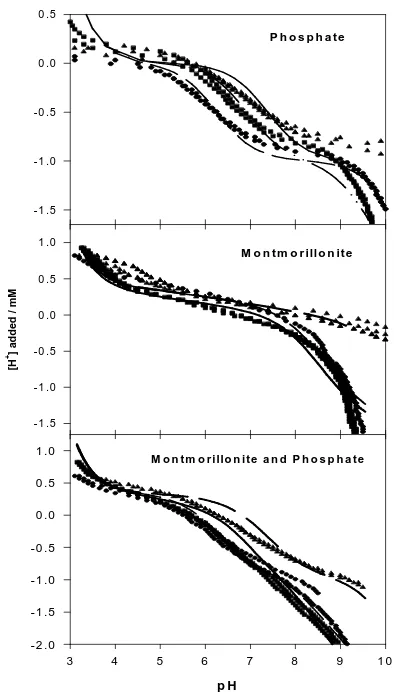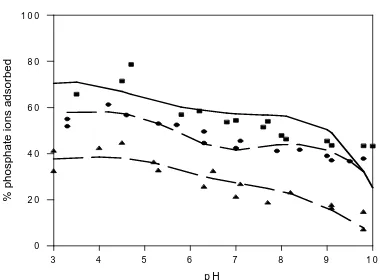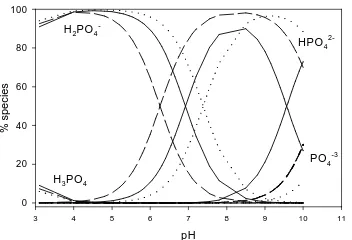See discussions, stats, and author profiles for this publication at: https://www.researchgate.net/publication/304168401
THERMODINAMIC PARAMETERS ON THE
SORPTION OF PHOSPHATE IONS BY
MONTMORILLONITE
Article · January 2015
READS
4
8 authors, including:
Jaslin Ikhsan
Universitas Negeri Yogyakarta
11PUBLICATIONS 222CITATIONS
SEE PROFILE
Endang Wijayanti
Universitas Negeri Yogyakarta
9PUBLICATIONS 35CITATIONS
SEE PROFILE
All in-text references underlined in blue are linked to publications on ResearchGate,
THERMODINAMIC PARAMETERS ON THE SORPTION OF PHOSPHATE IONS
BY MONTMORILLONITE
Jaslin Ikhsan*, Endang Wijayanti, dan Sunarto
Jurusan Pendidikan Kimia, Fakultas MIPA, Universitas Negeri Yogyakarta, Karangmalang, Yogyakarta, 55281
*
email: [email protected]
diterima 1 Desember 2014, disetujui 3 Maret 2015
Abstract
The sorption of phosphate by montmorillonite at 10, 30, and 50 oC were investigated aiming to mainly determine thermodynamic parameters for the formation of surface complexes in the adsorption of phosphate ions by montmorillonite. Data were collected by adsorption edge experiments investigating the effect of pH, adsorption isotherms enabling the effect of sorbate concentration, and acid-base titration calculating protons released or taken up by adsorption process. Data analysis was carried out using surface complexation model to fit the data collected in this study using the parameters obtained from previous study, as well as to calculate the values of ΔH and ΔS. Previous study reported that phosphate ions formed two outer-sphere surface complexes with active sites of montmorillonite through hydrogen bonding. In the first complex, [(XH)0– H2L─]─, the phosphate was held to permanent-charge X─ sites on the tetrahedral
siloxane faces, and the second complex, [[(SO─)(SOH)]– – [H2L]─] 2─was formed through the interaction between the
phosphate and variable charge surface hydroxyl groups at the edges of montmorillonite crystals and on the octahedral alumina faces. The values of ΔH for the first and second reactions are 39.756 and 3.765x10-7 kJ mol‒1 respectively. Since both reactions have positive enthalpy values, it can be concluded that the reactions are endothermic. Large energy for the first reaction is needed by X─ sites (permanent negatively charge sites of montmorillonite) to be partially desolvated, on which K+ or other surface cations are replaced by H+ ions in the surface protonated process, and are then ready to interact phosphate ions in the solution. Small values of ΔH for the second reactions indicates that hydrogen bonds formed by phosphate and SOH sites in the second reaction are easily broken out, and the phosphate can easily desorbed from the surface. The values of ΔS for the first and second reactions are 122.523 and 2.393 x10-2 J K‒1 mol‒1, which are greater than -10 kJ mol‒1 and indicates that the surface reactions occurs through dissociative mechanisms.
Keywords: montmorillonite, adsorption edge, extended constant capacitance, surface complexation model, enthalpy, reaction mechanisms
Introduction
The excess of phosphate can decrease water quality because of the decrease of oxygen-dissolved concentration. It can cause water creatures suffer and even die, and results in imbalance of water ecosystem. There are many methods to reduce phosphate excess in the soil and water. One of the methods is adsorption.
In the adsorption, temperature is one of factors that affect significantly adsorption process. It is reported that temperature can change characteristics of adsorption process by changing basic elements of a system, such as chemical properties of sorbate/sorbent, surface charges of sorbent, and adsorption reaction kinetics [1-4].
By studying the effect of temperature in the sorption system, Detail information about surface chemistry of the adsorption system can be obtained, by which researcher en able to control the thermodynamic system of the adsorption process. Adsorption process in different temperatures is always related to enthalpy (ΔH)
and entropy (ΔS). ΔH is total energy that involves in the adsorption process, whereas ΔS shows uncertainty in the system in which the higher the entropy, the higher the uncertainty.
The strength of the bond between sorbate and sorbent in the adsorption can be seen from ΔH values of the adsorption. If the ΔH involved in the adsorption is between -10 and -40 kJ/mol, the interaction between sorbate and sorbent is weak, called physisorption. In physisorption, interaction amongst the sorbate themselves is stronger than interaction between sorbate and sorbent. Physisorption process is always exothermic with small ΔH values. On the other hand, if the adsorption involves ΔH with the amount between -40 and -100 kJ/mol, the interaction for surface complex formation is by stronger chemical bond, called chemisorption [5].
Jaslin dkk./ J. Sains Dasar 2015 4 (1) 10 –16 11
function of temperature can be obtained. If temperature affect significantly to the adsorption, therefore the variation of temperature in an adsorption process will produce different equilbrium constants of surface complex formation between phosphate ions and surface sites, which can be used to calculate ΔH and ΔS
With K stands for equilibrium constant, T for temperature (Kelvin), and R for gas coefficient.
Referring to the arguments, this research was conducted to study the effects of temperature to the adsorption of phosphate ions by montmorillonite, to ascertain surface reactions and their equilibrium constants results from temperature variation. This research is also to determine the values of ΔH and ΔS on the adsorption of phosphate ions by montmorillonite.
Methods
Determination of Montmorillonite Surface Area. Montmorillonite samples were saturated by
using K+ ions, and its specific surface area was measured by using surface area meter NOVA 1000 which was 20.559475 m2/g.
Adsorption Experiments. The experiments
included 3 kinds of experiments; adsorption edge (adsorption as function pH), adsorption isotherm, and acid-base titration. Each adsorption experiment was done in the temperature of 10 oC, 30 0C, and 50 oC.
The adsorption edge was conducted to find
out pH influence on the adsorption. Into 200 mL suspension of 50 m2L-1 equilibrated using montmorillonite, KOH was added to reach the pH of the suspension about 10. Some amount of
minutes, 3 mL sample were taken and transferred to well-capped test tube. This experiment was repeated until the pH of the suspension reaches
about 3. All samples in the well-capped test tube were being stirred-up for a day (24 hours), the optimum time obtained from kinetic adsorption. After that, all samples were being centrifuged and the filtrate was analyzed for free phosphate ions in solution.
Adsorption isotherm was conducted to find
out the effect of phosphate concentration. The pH of 200 mL suspension of 50 m2L-1 montmorillonite was adjusted to be pH 4 and kept constant by adding KOH or HNO3. After that, 3
mL of solution stock of 0.01 M phosphate whose pH has already been adjusted to pH 4, added into suspension and let it equilibrates for the optimum time (24 hours, result from kinetic adsorption [6]. Sample was taken and put into well-caped test tube. Stock solution of phosphate, 5 mL was added again, and so on until total volume of stock solution added was 30 mL. All samples in the test tube were stirred-up for 1 day, and then were centrifuged and the filtrate was analyzed for phosphate free concentration.
Acid and base titration were analyzed
toward phosphate solution to determine the dissociative reactions, towards montmorillonite suspension to determine protonation and deprotonation of surface reactions, also towards suspension containing both montmorillonite and phosphate to find out surface complex reactions and their equilibrium constants. One hundred mL of 1 mM phosphate solution was added by KOH which usually filled by 30-50 minutes.
Titration towards suspension containing montmorillonite clay mineral only, and towards phosphate-montmorillonite were carried out in the same methods. Suspension has to be stirred first for 18 – 24 hours before it was titrated. Phosphate and montmorillonite concentrations were 1 mM and 100 m2L-1 respectively.
Determination of free phosphate ion concentration. Concentration of free phosphate
Data Analysis. Experiments data was constants at relevant temperatures. The model has been used in previous investigations [6, 9-15].
Result and Discussion
In general, parameters from the modeling at temperature of 30 oC [6] fit well to titration data at temperature of 10 and 50 oC (Figure 2-3) with full parameters are listed in Table 1, which means proposed reactions and their equilibrium constants from the modeling are good enough to explain the adsorption process. The modelling results was supported by adsorption kinetics [6], XRD diffractogram and IR spectrogram [15].
The model suggests four different results related to the surface of montmorillonite, e.i. (a) concentration of active sites,
(b) surface capacitance,
(c) surface reactions: protonation-deprotonation and surface complex formation, and
(d) equilibrium constants of both surface reactions.
Temperatures affect only the equilibrium constants of the reactions both protonation-deprotonation and surface complex formation as given in Table 1. Therefore, the parameters of a, b, and c were not affected by temperature and reported previously [6].
The reactions for surface protonation-deprotonation obtained from the modeling are given in Arabic numbers 1 – 3 below [6].
1. SOH + H+ SOH2 +
2. SOH SO- + H+
3. [X––H+]0 + K+ [X––K+]0 + H+
Whereas, the reactions for surface complex formation from the modeling are listed in the
Where SOH represents pH-dependently charged surface active sites and X– represents permanent negatively-charged sites of montmorillonite due to the isomorphous substitution. H2L─ is the
symbol for H2PO4─. The surface complex
reactions numbered 4 and 5 above are the main reactions representing the process of adsorption of phosphate ions by montmorillonite for which ΔH and ΔS are calculated. Therefore, the suface complexation reactions are then called by reactions 4 and 5 respectively.
P h o s p h a te
Figure 1. Acid-base titration to the systems at different
temperatures: (▲)10oC, (●) 30 oC, and (■) 50 oC. The lines were calculated using parameters as reported
previously [6] and in Tables 1-2.
The equilibrium constants of the above mentioned reactions are listed in Table 1.
Table 1.Equibrium constants of surface reactions in
different temperature calculated by ECCM
Jaslin dkk./ J. Sains Dasar 2015 4 (1) 10 –16 13
In addition, Figure 1 suggests that titration of phosphate solution at different temperatures shows different behaviour. Fitting of the titration data of phosphate solution gives thedeprotonation reactions: capacitance and site concentrations [6] were then used as fix parameters for adsorption edge data (Figure 2) and adsorption isotherm data (Figure 3).
Table 2. Equilibrium constants of phosphate
dissociation at different temperature
Thermodynamic parameters were then calculated using van’t Hoff equation based on the equilibrium constants obtained from the modeling. The thermodynamic parameters from the calculation are depicted in Table 3. Temperature affects the adsorption significantly. This can be seen from the experimental results both adsorption edge (Figure 2) and adsorption isotherm (Figure3). Effect of temperature to the adsorption has been reported, as the temperature can change the nature of sorbate, surface charges of sorbent, and reaction kinetics [1-4, 18, 19].
Table 3. Thermodynamic Parameter in Adsorption Process of Phosphate Ion by Montmorillonite
No. Reaction ∆H /
phosphate ion by 50 m2 L─1 montmorillonite at temperature of (▲)10 oC, (●) 30 oC, and (■) 50 oC. The lines were calculated using parameters as reported previously [6] and in
Tables 1-2.
Figure 3. Isotherm Adsorption of phosphate by
montmorillonite at pH 4 and temperature (▲)10 oC, (●) 30 oC, dan (■) 50 oC. The lines were calculated
using parameters as reported previously [6] and in Tables 1-2.
pH
Figure 4. Distribution of phosphate
speciation at different temperatures of (∙∙∙∙∙∙∙∙∙)10
o
C, (– – –) 30 oC and (––––) 50 oC, calculated with the parameters listed in Table 2.
This study also found that adsorption and desorption increased significantly due to the increase of temperature, which shows that surface complex formation is endothermic. ∆H value is a total amount of energy barrier that must be energy (Ea) which is represented by the equation,
Ea = ∆H + R T (T = 25 oC).
Scheckel and Sparks [21] found that the activation energy was not different for different temperature. The value of activation energy is calculated by using the formula shown above at T = 25 oC. This means that in this adsorption process, the value of Ea is 42.234 kJ mol-1 for reaction 4 and 2,478 kJ mol-1for reaction 5.
Kinetic sorption where some phosphate was not being desorbed easily from montmorillonite surface indicated that interaction between phosphate and X─surface sites that binds proton at low pH values (XH) is strong enough [6]. Strong energy is needed by X─sites to get partial desolvation in a protonation process, in which H+ exchanges K+ or cation saturated X─ active sites, to which phosphate ions are then bound. As a result, interlayer regions of montmorillonite decrease significantly [15].
Different observation was found on reaction
5. ∆H value for this reaction is very small (3.765x10-7 kJ mol─1). However, since the ∆H value is positive, so the reaction is endothermic. This indicates that hydrogen bond in surface complex formation in the reaction 5 is easily desorbed. As a consequence, kinetic sorption showed that some phosphate which has been
adsorbed by montmorillonite can be desorbed easily [6].
∆S value is an indication whether reaction occurs through associative or dissociative mechanism. If the value of ∆S > -10 kJ mol─1, it generally implies a dissociative reaction mechanism [21]. It is given in Table 3 that entropy value is positive for both reactions 4 and
5. The values of ∆S is large enough for the reaction 4, but small for the reaction 5. These ∆S values in this study indicates that surface compexation reactions in the adsorption of phosphate ion by montmorillonite occurs through dissociative mechanism. At reaction 4, X─ protonation reaction is a mechanism step which determines the reaction, in which K+ ions dissociates into solution and is replaced by proton H+, which finally interacts phosphate ions. While in the reaction 5, dissociation occurs when SOH active sites is deprotonated to release proton (H+) and then interacts phosphate ions.
Besides that, ∆S value is generaly dealing with desolvation process when K+ ions are released into solution by X─ permanently-negative charged sites. Similar argument was reported by Fokkink [22] that entropy of Cd(II) metal ion hydration of about 100 J K─1 mol─1 was obtained when the metal ions were adsorbed.
Value of ∆G for a reaction can be calculated by using equation of ∆G = ∆H –T ∆S, from which the values are small positive (for the reaction 4) and large positive (for the reaction 5). This indicates that surface complex formation in the adsorption of phosphate ions by montmorillonite can occur if energy is given to the system. The energy that is needed for the complex formation in reaction 4 is smaller than that in reaction 5.
Conclusion
Jaslin dkk./ J. Sains Dasar 2015 4 (1) 10 –16 15
ΔS values in both reactions which are larger than -10 kJ mol─1 indicates that both reactions occurs with contract No. 036/SP2H/PP/DP2M/III/2007. Writers would like to thank to DP2M.
Reference
[1] Benjamin, M.M. and Leckie, J.O. (1981). Competitive Adsorption of Cd, Cu, Zn, and Pb on Amorphous Iron Oxyhydroxide,
Journal of Colloids and Interface Sciences,
83: 410-415.
[2] Barrow, N. J. (1986). Testing a Mechanistic Model. II The Effect of Time and Temperature on the Reaction of Zinc with a Soil, Journal of Soil Sciences, 37: 277-283. [3] Johnson, B. B. (1990). Effect of pH,
Temperature, and Concentration on the Adsorption of Cadmium Goethite,
Environmental Science and Technology, 24:
112-117.
[4] Brady, P.V., Cygan, R.T., and Nagy, K. L. (1996). Molecular Control on Kaolinite Surface Charge, Journal of Colloid Interface
Science. 183: 1-7. oleh Geothite dan montmorillonite,
Proceeding: National Seminar, UNS
Solo-Indonesia, 476.
[7] Kabayama, M., Kawasaki, N., and Nakamura, T., Tokimoto, T., and Tanada, S. (2004). Adsorption of Phosphate Ions from Sea Water by Use of Surface-Modified Boehmite, Surface Scientific. 25(8): 499-503.
[8] Ludwig, C. (1992). GRFIT - A Computer
Program for Solving Speciation Problems: Evaluation of s, Concentration and Other
Physical Parameters. Switzerland:
University of Berne
[9] Ikhsan, J., Widjajanti LFX, E., and Sunarto. (2006) Study of Reaction Mechanisms on
the Adsorption of 9-Aminoacridine by Montmorillonite, Proceeding: International
Conference on Mathematics and Natural Sciences, ITB Bandung.
[10] Ikhsan, J., Wells, J.D., Johnson, B.B. and Angove, M.J. (2005). Surface Complexation Modeling of the Sorption of Zn(II) by Montmorillonite, Colloids and Surfaces A:
Physicochemical and Engineering Aspects,
252, 33-39.
[11] Ikhsan, J., Angove, M.J., Wells, J.D. and Johnson, B.B. (2005). Surface Complexation Modeling of the Sorption of 2-, 3-, and 4-aminopyridine by Montmorillonite, Journal
of Colloid and Interface Science, 284(2):
383-389.
[12] Angove, M.J., Fernandes, M.B. and Ikhsan, J. (2002). The Sorption of Anthracene onto Goethite and Kaolinite in the Presence of Some Benzene Carboxylic Acids, Journal of
Colloid and Interface Science, 247: 282-287.
[13] Ikhsan, J., Angove, M.J., Johnson, B.B. and Wells, J.D. (2005). Cosorption of Zn(II) and 2-, 3-, or 4-aminopyridine by Montmorillonite, Journal of Colloid and
Interface Science, 284(2): 400-405.
[14] Ikhsan, J., Wells, J.D. and Johnson, B.B. and Angove, B.B. (2005). Sorption of 3-amino-1,2,4-triazole and Zn(II) onto Montmorillonite, Clays and Clay Minerals, 53(2): 137-142.
[15] Ikhsan, J., Widjajanti LFX, E., and Sunarto. (2007). Memahami Proses Sorpsi Ion Fosfat
oleh Goethite dan Montmorillonite, Laporan
Penelitian Fundamental, Lembaga Penelitian UNY.
[16] Silberberg, M.S., (2000). Chemistry: The
Molecular Nature of Matter and Change,
2nd edition, Boston: Mc.Graw Hill, 776. [17] Anonym, http://inorg-phys.chem.itb.ac.id/
wp-content/uploads/2007/04/bab-9-10.pdf, accessed on October 29, 2008.
[18] Yadava, K.P., Tyagi, B.S, ang Singh, V.N. (1991). Effect Temperature on the Removal of Lead(II) by adsorption on China Clay and Wollasonite, Journal of Chemical Technology and Biotechnology, 51: 47-52.
[19] Brady, P.V. (1994). Alumina Surface Chemistry at 25, 40, and 60 C, Geochimica
et Cosmochimica Acta. 58, 1213.
[20] Jencks, M. P. (1969). Catalysis in Chemistry
and Enzymology, McGraw-Hill, New York.
Kinetics at the Mineral-Water Interface, Soil
Sci. Soc. Am. J., 65: 719-722.
[22] Fokkink, L.G.J., de Keizer A., and Lyklema, J. (1990). Temperature Dependance of Cadmium Adsorption on Oxides. 1. Experimental Observations and Model Analysis, Journal of Colloid and Interface


